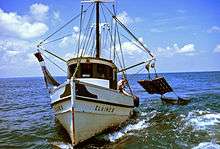Piscicide
A piscicide is a chemical substance which is poisonous to fish. The primary use for piscicides is to eliminate a dominant species of fish in a body of water, as the first step in attempting to populate the body of water with a different fish. They are also used to combat parasitic and invasive species of fish.
Examples of piscicides include rotenone,[1][2] saponins, TFM, niclosamide and Antimycin A (Fintrol).[3]
Plant-based piscicides
Historically, fishing techniques of indigenous people around the world have frequently included the use of plant-based piscicides. Many of these plants are natural sources of rotenone and saponins.
The genera Tephrosia, Wikstroemia, and Barringtonia are well known as fish poisons.
gollark: What if muons instead of electrons?
gollark: From the clickbaity title, this seems like one of those things which could easily go horribly wrong.
gollark: It's apparently related to the emission spectra of the metal ions in it.
gollark: I think I have one at home slowly degrading and probably releasing vaguely dangerous chemicals.
gollark: It's Discord's chemistry channel in most ways that count.
References
- Rotenone as a piscicide
- Rotenone Stewardship Program Archived 2007-11-10 at the Wayback Machine
- Susan J. Clearwater, Chris W. Hickey, Michael L. Martin Overview of potential piscicides and molluscicides for controlling aquatic pest species in New Zealand Science & Technical Publishing 2008 ISBN 978-0-478-14376-8
This article is issued from Wikipedia. The text is licensed under Creative Commons - Attribution - Sharealike. Additional terms may apply for the media files.
